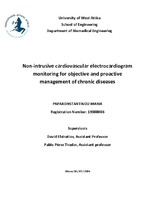Non-intrusive cardiovascular electrocardiogram monitoring for objective and proactive management of chronic diseases
Μη παρεμβατική καρδιαγγειακή παρακολούθηση με την χρήση ηλεκτροκαρδιογραφήματος, για αντικειμενική και προληπτική διαχείριση χρόνιων παθήσεων

Διπλωματική εργασία
Συγγραφέας
Παπακωνσταντίνου, Μαρία
Ημερομηνία
2024-10-21Επιβλέπων
David, StratosPérez-Tirador, Pablo
Λέξεις-κλειδιά
cECG ; Signal proccesing ; ElectrodesΠερίληψη
This thesis explores the development and implementation of a non-intrusive cardiovascular electrocardiogram (ECG) monitoring system designed for proactive chronic disease management. Traditional ECG methods, using gel and dry electrodes, require direct skin contact, often causing discomfort and irritation. This project addresses these issues using coupled ECG (cECG) technology to acquire signals through clothing. The research involved creating sensorized furniture with integrated sensors for non intrusive ECG recording. Initially, a circuit with two electrodes was built to conduct preliminary experiments. Extensive characterization of materials and electrodes was performed to optimize configurations for signal acquisition. Various fabrics and conductive materials were tested for their effectiveness in transmitting ECG signals, and electrodes were assessed for conductivity and flexibility. Experiments evaluated the impact of insulation, moisture, and electrode size on signal quality. Then, a second circuit was constructed, adding a reference electrode to facilitate calibration trials. These trials, involving diverse human volunteers, ensured accurate signal capture and assessed the prototype's performance under different conditions. Results indicated that the cECG system effectively captures signals. Increased pressure improved the clarity of the ECG signals, while moisture played a catalytic role in maintaining signal integrity during experiments. In tests with volunteers, 75% were had visible QRS peaks with moisture, while only the 25% without its addition.

